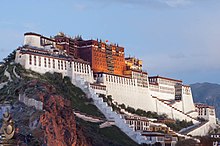16 CENTRAL ASIA
By the mid-17th century, the power dynamics in Central Asia were undergoing a significant transformation. The Russian Empire’s desire for fur and other resources led to its eastward expansion, culminating in its reach to the Pacific coast by 1649, marking a significant milestone in its territorial ambitions. This expansion was part of a broader process of fragmentation, as the once-dominant nomadic groups gave way to various regional powers vying for influence. To the south and east, parts of Mongolia came under the control of the Qing (Manchu) dynasty, although the western region, known as Outer Mongolia, maintained a degree of autonomy. This precarious balance was disrupted later in the century when Galdan Boshugtu Khan (1644–1697), a leader of the Dzungar Mongols, launched military campaigns against the Qing dynasty, intensifying regional conflicts and setting the stage for further upheavals.
The old Uzbek territories northeast of the Caspian Sea became a strategic battleground, with various powers, including the Russians, Chinese, and Mongols, vying for influence and control. This region, rich in resources and strategic trade routes, was a coveted prize for the competing empires. In Tibet, the construction of the Potala Palace in Lhasa, begun in the 7th century and completed largely between 1645 and 1694, symbolized the region’s rich cultural heritage and the prominence of Tibetan Buddhism. This impressive structure served as the winter residence of the Dalai Lama and a beacon of stability amid the surrounding upheavals. The Potala Palace stood as a testament to the region’s architectural and artistic achievements, showcasing the unique blend of Tibetan, Chinese, and Indian influences.
The 17th century marked a transformative period in the region’s history, characterized by the rise and fall of empires and the shifting alliances between Mongols, Chinese, and Russians. While the Potala Palace stood as a testament to Tibetan culture, the broader geopolitical landscape of Central Asia and the surrounding areas was marked by intense competition and change. This era set the stage for further transformations that would shape the future of Asian history, including the expansion of European colonial powers and the eventual decline of traditional empires. As the regional powers continued to vie for influence, the complex web of alliances and rivalries would lead to further conflicts and power struggles. The late 17th century marked a turning point in the region’s history, as the old order gave way to new challenges and opportunities.
The Potala Palace (Source: Wikimedia Commons)

